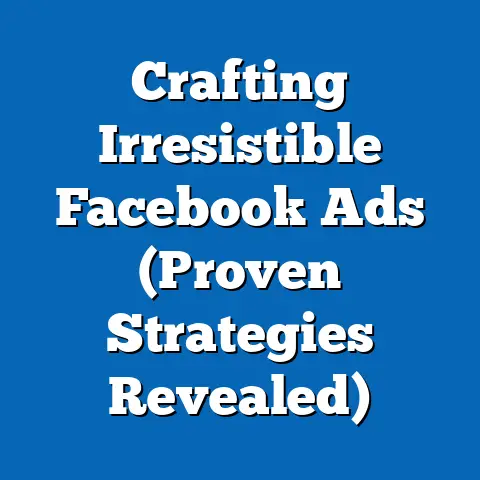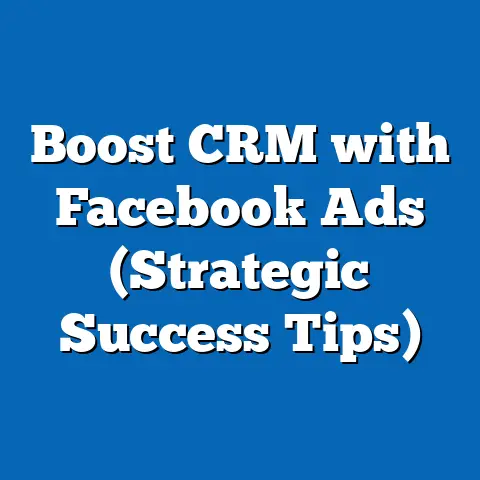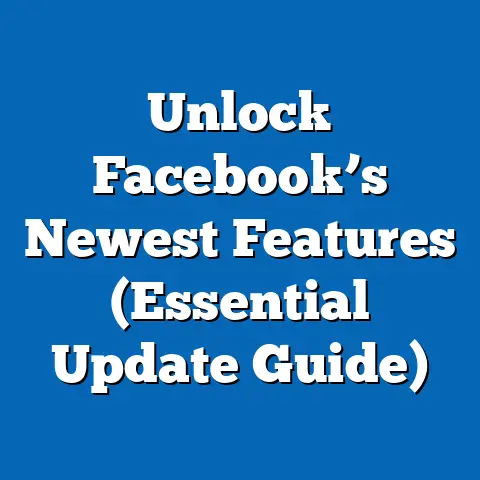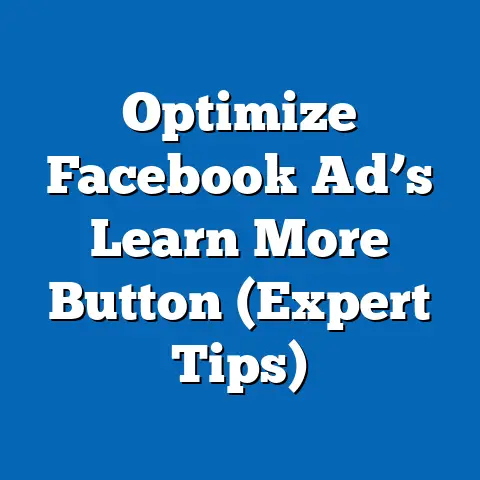Boost Facebook Marketplace Ad Effectively (Pro Tips)
Facebook, despite the ever-evolving digital landscape, remains a powerhouse for advertising. And within this vast ecosystem, Facebook Marketplace has carved out a significant niche, becoming a go-to platform for both businesses and individuals looking to connect with buyers. Over the years, I’ve witnessed its transformation from a simple online garage sale to a sophisticated e-commerce hub. The beauty of Facebook Marketplace lies in its immense audience reach, coupled with the potential for genuine, organic engagement. It’s not just about throwing money at ads; it’s about creating a connection with potential customers in a space where they’re already browsing and looking to buy.
I’ve seen firsthand how a well-crafted Marketplace ad can outperform traditional advertising campaigns. The key is understanding how the platform works, crafting compelling visuals and copy, and targeting your audience with precision. In this guide, I’ll share pro tips and actionable strategies to help you effectively boost your Facebook Marketplace ads and unlock the platform’s full potential. According to recent data, Facebook Marketplace boasts over a billion monthly users, and that number is only growing. This represents a massive opportunity for sellers to tap into a highly engaged audience and drive sales. Whether you’re a small business owner or an individual selling pre-loved items, Facebook Marketplace can be a game-changer. My goal is to equip you with the knowledge and tools you need to succeed in this dynamic environment. Let’s dive in!
1. Understanding Facebook Marketplace
Before we get into the nitty-gritty of boosting your ads, let’s take a step back and understand what Facebook Marketplace actually is and its role within the larger Facebook universe.
What is Facebook Marketplace?
Facebook Marketplace is essentially a digital marketplace embedded within the Facebook platform. It allows users to buy and sell items locally, connect with other buyers and sellers, and discover deals on a wide range of products. Think of it as a virtual flea market, but with the added benefits of Facebook’s social network and advertising capabilities.
Who’s Hanging Out in the Marketplace?
The target audience on Facebook Marketplace is incredibly diverse, reflecting the broad user base of Facebook itself. You’ll find everyone from young adults looking for furniture for their first apartment to families selling used baby gear to small business owners offering handcrafted goods.
Understanding the demographics and buying behaviors of Marketplace users is crucial for crafting effective ads. Generally, Marketplace users are looking for good deals, convenience, and local options. They’re often price-sensitive and appreciate the ability to negotiate and connect directly with sellers. I’ve noticed that many users value the community aspect of Marketplace, preferring to buy from local individuals or businesses rather than large corporations.
Marketplace Ads vs. Traditional Facebook Ads: What’s the Difference?
While both Marketplace ads and traditional Facebook ads appear on the Facebook platform, they serve different purposes and have distinct characteristics. Traditional Facebook ads are typically used to drive traffic to a website, generate leads, or promote brand awareness. They can appear in various placements, including the news feed, right column, and Instagram.
Marketplace ads, on the other hand, are specifically designed to promote products for sale on the Marketplace. They appear directly within the Marketplace browsing experience and are targeted to users who are actively searching for items to buy. The key difference is intent. Marketplace users are generally further down the sales funnel, actively seeking products, while traditional Facebook ad viewers may be more passively consuming content.
User Experience is King (and Queen)
The user experience is paramount on Facebook Marketplace. Users expect a seamless and intuitive browsing experience, with clear product listings, high-quality images, and easy communication with sellers. A clunky or confusing ad can quickly turn off potential buyers. Make sure your ads are visually appealing, easy to understand, and provide all the necessary information for users to make a purchasing decision. I’ve found that ads with clear and concise descriptions, multiple high-resolution photos, and a responsive seller tend to perform the best.
Key Takeaway: Facebook Marketplace is a powerful platform with a diverse audience and unique advertising characteristics. Understanding the platform’s nuances and prioritizing user experience are essential for success.
2. Crafting Compelling Ads
Now, let’s get to the heart of the matter: crafting compelling ads that grab attention and drive sales on Facebook Marketplace.
The Anatomy of a High-Converting Ad
A high-converting Facebook Marketplace ad consists of several key elements working in harmony:
- Visuals: High-quality images are crucial for capturing attention and showcasing your product.
- Headline: A clear and concise headline that immediately communicates the value proposition.
- Description: A persuasive and informative description that highlights the benefits of your product.
- Price: A competitive price that attracts buyers without sacrificing your profit margin.
- Call to Action: A clear call to action that tells users what you want them to do (e.g., “Message Seller,” “Buy Now”).
Picture This: Eye-Catching Images
Your images are often the first thing potential buyers will see, so make them count! Here are some tips for creating eye-catching images:
- Use high-resolution photos: Blurry or pixelated images will turn off potential buyers.
- Showcase your product from multiple angles: Give users a comprehensive view of what they’re buying.
- Use natural lighting: Avoid harsh shadows or artificial lighting that can distort the product’s appearance.
- Stage your product effectively: Create a visually appealing backdrop that complements your product.
- Include lifestyle shots: Show your product in use to help buyers visualize how it fits into their lives.
I remember once helping a friend sell a vintage armchair on Marketplace. Initially, her photos were dark and poorly lit, and the chair looked drab and unappealing. After we re-photographed it in a bright, sunny room with some stylish throw pillows, the ad received a flood of inquiries and sold within a day. The power of good visuals cannot be overstated!
Words That Sell: Persuasive Copy
Your ad copy should be persuasive, informative, and tailored to your target audience. Focus on the benefits of your product rather than just its features. What problem does it solve? How will it improve the buyer’s life?
Here are some tips for writing effective ad copy:
- Example 1: A used bicycle for sale. The ad features a clear, well-lit photo of the bicycle, a concise headline (“Men’s Mountain Bike – Excellent Condition”), and a detailed description that highlights its features and condition. The price is competitive, and the call to action is clear (“Message Seller”).
- Example 2: A handcrafted wooden table. The ad features a stunning photo of the table in a beautifully decorated living room. The headline (“Handcrafted Solid Wood Table – Unique Design”) emphasizes its unique value proposition. The description highlights the quality of the materials and the craftsmanship involved. The price is higher than average, but the ad appeals to buyers who are looking for a unique and high-quality piece of furniture.
What do these successful ads have in common? They all feature high-quality visuals, persuasive copy, competitive pricing, and clear calls to action. They also understand their target audience and tailor their messaging accordingly.
Key Takeaway: Compelling ads are the cornerstone of success on Facebook Marketplace. Invest time and effort in creating high-quality visuals and persuasive copy that resonates with your target audience.
3. Targeting Your Audience Effectively
Crafting compelling ads is only half the battle. To truly boost your Facebook Marketplace ads, you need to target your audience effectively.
The Power of Precise Targeting
Facebook’s targeting capabilities are one of its biggest strengths. By leveraging the platform’s vast data on user interests, demographics, and behaviors, you can ensure that your ads reach the right people.
Segmenting Your Audience
Here are some ways to segment your audience on Facebook Marketplace:
- Location: Target users within a specific radius of your location.
- Interests: Target users who have expressed interest in related topics or products.
- Demographics: Target users based on age, gender, education, and other demographic factors.
- Behavior: Target users based on their online activity, such as their purchasing history or their engagement with specific types of content.
Unlocking Insights with Audience Insights
Facebook’s Audience Insights tool can be a valuable resource for understanding your target market. This tool allows you to explore the demographics, interests, and behaviors of your potential customers, helping you to refine your targeting strategy. I often use Audience Insights to identify new interests or demographics that I hadn’t considered before.
Refining Your Targeting: A Practical Approach
Here are some practical tips for refining your audience targeting:
- Start broad, then narrow down: Begin with a broad audience and gradually narrow your targeting based on performance data.
- Test different audience segments: Experiment with different combinations of interests, demographics, and behaviors to see what works best.
- Use lookalike audiences: Create lookalike audiences based on your existing customers or website visitors.
- Monitor your ad performance closely: Pay attention to which audience segments are driving the most conversions and adjust your targeting accordingly.
Key Takeaway: Effective audience targeting is crucial for maximizing the ROI of your Facebook Marketplace ads. Leverage Facebook’s targeting capabilities and use data-driven insights to reach the right people with your message.
4. Leveraging Facebook’s Tools and Features
Facebook offers a range of tools and features that can enhance your Marketplace ads and improve your overall performance.
A/B Testing: The Science of Optimization
A/B testing, also known as split testing, is a powerful technique for optimizing your ads. It involves creating two different versions of an ad (e.g., with different headlines, images, or descriptions) and showing them to different segments of your audience. By tracking the performance of each version, you can identify which one is more effective and use that knowledge to improve your ads. I always recommend A/B testing different ad elements to see what resonates best with your target audience.
Facebook Pixel: Tracking Conversions and Gathering Data
The Facebook Pixel is a small snippet of code that you can install on your website to track conversions and gather data about your website visitors. This data can be used to optimize your ads, create retargeting campaigns, and measure the overall effectiveness of your advertising efforts.
Instagram Shopping: Expanding Your Reach
If you sell products online, consider integrating your Marketplace ads with Instagram Shopping. This allows you to showcase your products directly on Instagram and reach a wider audience. Instagram Shopping can be a particularly effective strategy for businesses that sell visually appealing products, such as clothing, accessories, or home decor.
Retargeting: Staying Top of Mind
Retargeting involves showing ads to users who have previously interacted with your business, such as visiting your website or viewing your products on Marketplace. This can be a highly effective way to re-engage potential buyers and drive conversions. For example, you could retarget users who added a product to their cart but didn’t complete the purchase.
Key Takeaway: Facebook offers a suite of powerful tools and features that can help you optimize your Marketplace ads and achieve better results. Leverage these tools to test different strategies, track your performance, and expand your reach.
5. Measuring Success and Optimizing Campaigns
Measuring the success of your Facebook Marketplace ads is essential for understanding what’s working and what’s not.
Key Performance Indicators (KPIs)
Here are some key performance indicators (KPIs) that you should track to measure the success of your ads:
- Impressions: The number of times your ad is displayed.
- Reach: The number of unique users who see your ad.
- Click-Through Rate (CTR): The percentage of users who click on your ad after seeing it.
- Conversion Rate: The percentage of users who complete a desired action (e.g., making a purchase) after clicking on your ad.
- Cost Per Acquisition (CPA): The cost of acquiring a new customer through your ad campaign.
- Return on Ad Spend (ROAS): The amount of revenue generated for every dollar spent on advertising.
Analyzing Ad Performance Data
Regularly analyze your ad performance data to identify trends and patterns. Which ads are performing well? Which ones are underperforming? Which audience segments are driving the most conversions? Use this data to make informed decisions about your advertising strategy.
Continuous Improvement: A Framework for Success
Continuous improvement is essential for maximizing the ROI of your Facebook Marketplace ads. Here’s a framework for continuous improvement:
- Set clear goals: Define what you want to achieve with your ads.
- Track your performance: Monitor your KPIs and identify areas for improvement.
- Test different strategies: Experiment with different ad formats, targeting options, and bidding strategies.
- Analyze your results: Evaluate the performance of your different strategies and identify what works best.
- Implement your findings: Apply your learnings to improve your ads and optimize your campaigns.
- Repeat: Continuously monitor, test, and optimize your ads to achieve ongoing success.
Common Pitfalls to Avoid
Here are some common pitfalls to avoid when measuring success on Marketplace:
- Focusing on vanity metrics: Don’t get distracted by metrics like impressions and reach. Focus on metrics that directly impact your bottom line, such as conversion rate and ROAS.
- Making assumptions: Don’t assume you know what works best. Test different strategies and let the data guide your decisions.
- Ignoring seasonality: Be aware of seasonal trends that can impact your ad performance.
- Failing to adapt: The Facebook Marketplace landscape is constantly evolving. Stay up-to-date with the latest trends and best practices and be prepared to adapt your strategy accordingly.
Key Takeaway: Measuring success and optimizing campaigns are crucial for maximizing the ROI of your Facebook Marketplace ads. Track your KPIs, analyze your data, and continuously improve your strategy to achieve ongoing success.
Conclusion
Boosting your Facebook Marketplace ads effectively requires a combination of strategic planning, creative execution, and data-driven optimization. By understanding the platform’s nuances, crafting compelling ads, targeting your audience with precision, leveraging Facebook’s tools and features, and measuring your success, you can unlock the full potential of Facebook Marketplace and drive significant sales.
I encourage you to implement the pro tips shared in this article to maximize your advertising efforts on this powerful platform. Remember, Facebook Marketplace is a dynamic and evolving environment, so it’s important to stay up-to-date with the latest trends and best practices.
With the right strategies and a commitment to continuous improvement, Facebook Marketplace can be a game-changer for your business. Embrace the opportunity, experiment with different approaches, and watch your sales soar. The potential is there; it’s up to you to unlock it!






